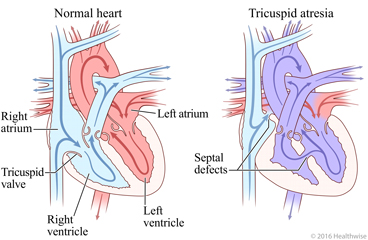
What is tricuspid atresia?
Tricuspid atresia (say "try-KUSS-pid uh-TREE-zhuh") is a type of congenital heart disease. Congenital heart disease refers to heart problems a baby is born with. These heart problems are usually diagnosed at or before birth.
The heart is a muscular pump with four chambers. The two top chambers are the left atrium and right atrium. The two bottom chambers are the left ventricle and the right ventricle. Normally, blood flows from the right atrium into the right ventricle. The tricuspid valve between these two chambers keeps the blood moving forward and prevents backflow.
"Atresia" means "not there." So in tricuspid atresia, the tricuspid valve isn't there. There is no opening. Blood does not flow through the heart as well as it should. The baby does not get enough oxygen.
The lack of this valve can also cause other problems. The right ventricle usually doesn't develop well and is too small. The aorta and the pulmonary artery—the two main blood vessels leading to and from the heart—may also be too small.
Most babies with this problem also have other heart problems, like an opening between the right and left sides of the heart.
Your baby may need special care, such as being in the neonatal intensive care unit (NICU). This may be scary for you. But the hospital staff understands this. They will explain what happens and will answer your questions.
How is tricuspid atresia diagnosed?
Your doctor may hear abnormal heart sounds, such as a heart murmur, when examining your newborn.
Your doctor will order tests to find the cause of abnormal sounds or of symptoms. The most common test used to identify this problem is called an echocardiogram, or "echo" for short. It uses sound waves to make an image of your baby's heart.
Your baby may have other tests, such as an ECG or EKG (electrocardiogram), chest X-ray, and checking the amount of oxygen in the blood.
A fetal ultrasound, which lets your doctor see an image of your baby before birth, sometimes finds this problem.
What are the symptoms?
Symptoms may include:
- A blue tint to the skin, lips, or fingernails.
- Fast breathing.
- Sweating while feeding.
- Not eating well.
- Being fussy a lot of the time.
How is it treated?
Your doctor will help you understand your baby's condition, your treatment choices, and what to expect from each choice.
Your baby may get medicine that helps keep oxygen-rich blood flowing to the body. It is often given through a blood vessel in the belly button.
Your baby will have surgery to help open the blood vessel that carries blood from the heart to the lungs. What the doctor does during surgery depends on how well blood is flowing through the heart and how small the right ventricle is. Your baby will be asleep during the surgery.
Your baby will probably need more than one surgery.
What can you expect?
- You may see tubes and wires attached to your baby. This can be scary to see. But these things help the doctor treat your baby. The tubes supply air, fluid, and medicines to your baby. The wires are attached to machines that help the doctor keep track of your baby's vital signs. These include temperature, blood pressure, breathing rate, and pulse rate.
- It may seem that your baby is getting lots of tests. All of these tests help your doctor keep track of your baby's condition and give the best treatment possible.
- If your baby has trouble breathing, the doctor may use a ventilator. This machine helps your baby breathe. To use the machine, the doctor puts a soft tube through your baby's mouth into the windpipe.
- The hospital staff will give your baby the nutrition that your baby needs. The doctor may feed your baby through a soft tube that goes through the nose and into the stomach. Or the doctor may use an I.V. that goes through the belly button to do this.
- After surgery, your baby will need routine checkups to check on the heart.
- It's hard to be apart from your baby, especially when you worry about your baby's condition. Know that the hospital staff is well prepared to care for babies with this condition. They will do everything they can to help. If you need it, get support from friends and family. Ask the hospital staff about counselling and support.
Follow-up care is a key part of your child's treatment and safety. Be sure to make and go to all appointments, and call your doctor or nurse advice line (811 in most provinces and territories) if your child is having problems. It's also a good idea to know your child's test results and keep a list of the medicines your child takes.
Where can you learn more?
Go to https://www.healthwise.net/patientEd
Enter F732 in the search box to learn more about "Learning About Tricuspid Atresia in Newborns".
